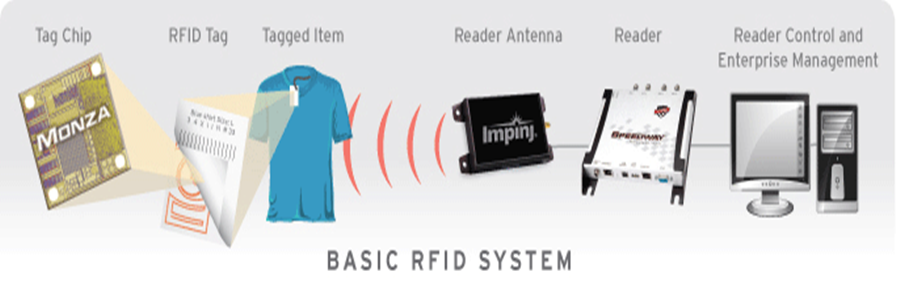A basic RFID systems include:Tag, Tag antennas and RFID Solution.
In a basic RFID systems, tags are attached to all items that are to be tracked. These tags are made from a tiny tag-chip, sometimes called an integrated circuit (IC), that is connected to an antenna that can be built into many different kinds of tags including apparel hang tags, labels, and security tags, as well as a wide variety of industrial asset tags. The tag chip contains memory which stores the product’s electronic product code (EPC) and other variable information so that it can be read and tracked by RFID readers anywhere.
An RFID reader is a network connected device (fixed or mobile) with an antenna that sends power as well as data and commands to the tags. The RFID reader acts like an access point for RFID tagged items so that the tags’ data can be made available to business applications.
RFID Tags
An RFID tag is comprised of an integrated circuit (called an IC or chip) attached to an antenna that has been printed, etched, stamped or vapor-deposited onto a mount which is often a paper substrate or PolyEthylene Therephtalate (PET). The chip and antenna combo, called an inlay, is then converted or sandwiched between a printed label and its adhesive backing or inserted into a more durable structure.
Tag Chip
The tag’s chip or integrated circuit (IC) delivers performance, memory and extended features to the tag. The chip is pre-programmed with a tag identifier (TID), a unique serial number assigned by the chip manufacturer, and includes a memory bank to store the items’ unique tracking identifier (called an electronic product code or EPC).
Electronic Product Code (EPC)
The electronic product code (EPC) stored in the tag chip’s memory is written to the tag by an RFID printer and takes the form of a 96-bit string of data. The first eight bits are a header which identifies the version of the protocol. The next 28 bits identify the organization that manages the data for this tag; the organization number is assigned by the EPC global consortium. The next 24 bits are an object class, identifying the kind of product; the last 36 bits are a unique serial number for a particular tag. These last two fields are set by the organization that issued the tag. The total electronic product code number can be used as a key into a global database to uniquely identify that particular product.
Tag Antennas
Tag antennas collect energy and channel it to the chip to turn it on. Generally, the larger the tag antenna’s area, the more energy it will be able to collect and channel toward the tag chip, and the further read range the tag will have.
RFID Readers
An RFID reader, also known as an interrogator, is a device that provides the connection between the tag data and the enterprise system software that needs the information. The reader communicates with tags that are within its field of operation, performing any number of tasks including simple continuous inventorying, filtering (searching for tags that meet certain criteria), writing (or encoding) to selected tags, etc.
Reader Antennas
RFID readers and reader antennas work together to read tags. Reader antennas convert electrical current into electromagnetic waves that are then radiated into space where they can be received by a tag antenna and converted back to electrical current. Just like tag antennas, there is a large variety of reader antennas and optimal antenna selection varies according to the solution’s specific application and environment.
Reader Control and Application Software
Reader control and application software, also known as middleware, helps connect RFID readers with the applications they support. The middleware sends control commands to the reader and receives tag data from the reader.
Creating an RFID Solution
Deploying an RFID systems necessitates multiple actors and many different components. Typically, installing a system requires basic hardware-including tag chips, tag antennas, readers, and reader antennas-as well as reader control and application software, and solution providers to put it all together. When all of these components come together, an infinite number of creative applications are possible. RFID systems applications can help improve the quality of business operations, inventory and customer experience in a variety of industries.







